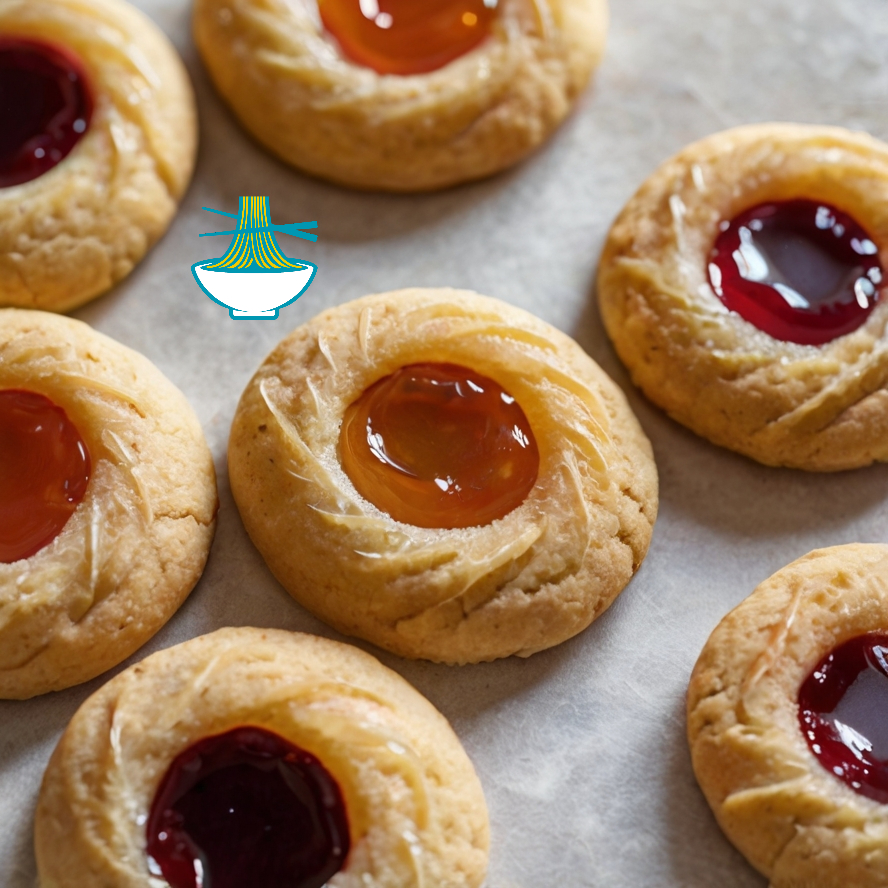Thumbprint Cookies, while primarily a treat to satisfy your sweet tooth, also offer a comforting combination of buttery goodness and fruit-filled sweetness. The main ingredients—butter, flour, and sugar—provide energy-boosting carbohydrates and healthy fats, especially when paired with fruit preserves, which offer vitamins and antioxidants. Though these cookies are indulgent, the presence of fruit preserves can add a slight boost of vitamin C, helping to support immune function. However, it's important to enjoy these cookies in moderation, as they are typically high in sugars and fats, which can be a concern if consumed in excess. Whether you make them for a family gathering or a personal snack, Thumbprint Cookies are sure to bring a smile.
Ingredients:
- 1 cup unsalted butter, softened
- 1/2 cup granulated sugar
- 2 cups all-purpose flour
- 1/4 teaspoon salt
- 1/2 teaspoon vanilla extract
- 1/4 cup fruit preserves or jam (such as raspberry, strawberry, or apricot)
- 1 egg (optional for egg wash)
Preparation:
Preheat the Oven
- Begin by preheating your oven to 350°F (175°C). This ensures that your oven reaches the right temperature for an even bake. While the oven is heating, prepare your baking sheet by lining it with parchment paper. This prevents the cookies from sticking and makes cleanup easier.
Cream the Butter and Sugar
- In a large mixing bowl, combine 1 cup of softened unsalted butter with 1/2 cup of granulated sugar. Using a hand mixer or stand mixer, beat the ingredients together on medium speed until the mixture becomes light and fluffy. This process incorporates air into the butter, making your cookies tender and soft.
Incorporate Dry Ingredients
- Gradually add 2 cups of all-purpose flour and 1/4 teaspoon of salt to the creamed butter and sugar mixture. Continue mixing until the dough comes together. The dough should be smooth and slightly soft. If it feels too sticky, add a little more flour, one tablespoon at a time, until the desired consistency is reached.
Shape the Dough
- Take small portions of the dough and roll them into balls, each about 1 inch in diameter. Place the dough balls onto the prepared baking sheet, spacing them about 2 inches apart to give them room to spread while baking.
Create Indentations
- Once the dough balls are arranged on the baking sheet, use your thumb (or the back of a spoon) to gently press down into the center of each ball, creating a small indentation. This indentation will hold the fruit preserves and give the cookies their signature thumbprint shape.
Fill with Fruit Preserves
- Spoon about 1/2 teaspoon of fruit preserves or jam (such as raspberry, strawberry, or apricot) into the center of each cookie indentation. Be careful not to overfill, as the preserves may overflow during baking.
Bake the Cookies
- Place the baking sheet in the preheated oven and bake for 10-12 minutes. Keep an eye on the cookies as they bake; the edges should turn lightly golden, while the centers remain soft. Baking times may vary depending on your oven, so be sure to check the cookies around the 10-minute mark.
Cool Before Serving
- Once baked, remove the cookies from the oven and allow them to cool on the baking sheet for a few minutes. Afterward, transfer them to a wire rack to cool completely. This step helps the cookies firm up and makes them easier to handle without breaking.
Improving Thumbprint Cookies Recipe
Healthy Tips for Making Thumbprint Cookies: To make Thumbprint Cookies healthier, consider these simple substitutions:
- Butter Alternatives: Instead of using regular unsalted butter, try plant-based butter or even coconut oil for a healthier fat profile. These alternatives can provide similar texture and richness while offering a more plant-friendly option.
- Sugar Alternatives: Replace granulated sugar with natural sweeteners like honey, maple syrup, or stevia. These options are lower on the glycemic index and can be a better choice for those watching their sugar intake.
- Flour Substitutes: Instead of all-purpose flour, opt for whole wheat flour or almond flour for a boost of fiber and nutrients. Whole wheat flour contains more fiber and nutrients, while almond flour is gluten-free and a good option for those following a gluten-free diet.
Alternative Filling Options: While fruit preserves like raspberry, strawberry, or apricot are classic choices, you can experiment with different fillings for a unique twist. Some alternative ideas include:
- Peanut Butter: Spread a dollop of peanut butter in the center of the cookie for a creamy, protein-packed option.
- Dark Chocolate: Instead of fruit preserves, fill the cookies with a piece of dark chocolate. It adds an indulgent, rich flavor with antioxidant benefits.
- Nut Butters: Almond or cashew butters can be used as a filling for a more nutritious, creamy center.
Potential Risks of Overindulgence: While Thumbprint Cookies are delicious, it's important to consume them in moderation. Excessive consumption can lead to:
- Weight Gain: The combination of butter and sugar in these cookies means they are high in calories, which can contribute to weight gain if consumed in large amounts.
- Blood Sugar Spikes: Because of the high sugar content, frequent overconsumption may cause spikes in blood sugar levels, which can be problematic for individuals with diabetes or insulin resistance.
- Heart Health: The saturated fats found in butter, if consumed in excess, may negatively affect heart health over time. This can increase the risk of high cholesterol and cardiovascular disease.
Serving Suggestions: Thumbprint Cookies are versatile and can be paired with various beverages and treats for a delightful experience. Here are a few ideas:
- Tea or Coffee: Serve the cookies alongside a hot cup of tea or coffee. The combination of the buttery texture with the warm beverage creates a comforting treat.
- Ice Cream: Serve the cookies with a scoop of vanilla or fruit-flavored ice cream. The contrast of the cold ice cream with the warm, soft cookie is a treat for the senses.
- Milk: For a classic pairing, serve these cookies with a glass of cold milk, especially if you opt for a richer chocolate or peanut butter filling.
Frequently Asked Questions
Can these cookies be made without eggs?
- Yes! You can replace eggs with alternatives like flaxseed meal (mix 1 tablespoon of flaxseed with 3 tablespoons of water, and let it sit for a few minutes to form a gel) or mashed bananas. These options provide a similar binding function without the need for eggs.
How should I store these cookies?
- To preserve the freshness and texture of your Thumbprint Cookies, store them in an airtight container at room temperature for up to one week. For longer storage, you can freeze the cookies. Simply layer them between parchment paper, place them in a freezer-safe bag, and they will stay fresh for up to 3 months.
Can I use sugar-free jam or preserves?
- Absolutely! If you want to reduce the sugar content, you can use sugar-free fruit preserves or unsweetened fruit jams. These options are sweetened naturally with fruit and contain fewer sugars, making them a great option for those on a low-sugar diet.
What are some healthier alternatives for the ingredients in the recipe?
You can make several adjustments to make the recipe healthier:
- Butter: Use coconut oil or a plant-based butter.
- Sugar: Substitute with honey, maple syrup, or stevia.
- Flour: Try using whole wheat flour, almond flour, or oat flour for a more nutritious option.
- Egg: Use flaxseed meal or mashed banana for an egg-free version.
Are these cookies suitable for low-sugar or gluten-free diets?
Yes, Thumbprint Cookies can be adapted for both low-sugar and gluten-free diets:
- Low-Sugar: Use sugar substitutes like stevia or monk fruit sweetener to reduce the sugar content.
- Gluten-Free: Substitute the all-purpose flour with almond flour or a gluten-free flour blend to make the cookies gluten-free. Make sure your jam or preserve is also gluten-free.

Nutritional Values and Benefits
Unsalted Butter (1 cup)
- Calories: 1,600
- Fat: 184g
- Carbohydrates: 1g
- Protein: 1g
Nutritional Benefit: Butter provides a rich source of saturated fat, which, when consumed in moderation, supports brain function and energy. It also contains vitamins A and D, which promote healthy skin and immune function.
Granulated Sugar (1/2 cup)
- Calories: 400
- Carbohydrates: 100g
Nutritional Benefit: While sugar provides a quick source of energy, it’s best consumed in moderation. Excessive sugar intake can lead to health issues, but in small quantities, it helps provide a quick burst of energy.
All-purpose Flour (2 cups)
- Calories: 910
- Carbohydrates: 190g
- Protein: 30g
- Fat: 2g
Nutritional Benefit: Flour provides essential carbohydrates, which serve as a primary energy source. It also contributes small amounts of protein, but it lacks fiber unless whole wheat flour is used.
Fruit Preserves or Jam (1/4 cup)
- Calories: 200
- Carbohydrates: 52g
Nutritional Benefit: Fruit preserves add a touch of natural sweetness along with antioxidants, vitamins, and minerals, especially vitamin C, which is vital for immune health. It also contains dietary fiber, which supports digestion.
Egg (Optional for egg wash)
- Calories: 70
- Protein: 6g
- Fat: 5g
- Carbohydrates: 1g
Nutritional Benefit: Eggs provide high-quality protein and healthy fats, supporting muscle growth and repair. They are also a good source of vitamins like B12 and D, which are essential for energy and bone health.
Thumbprint Cookies are a classic and indulgent treat that can offer a small nutritional boost from the fruit preserves. While they are high in calories, fats, and sugars, these cookies can still fit into a balanced diet when enjoyed in moderation. Their fruity filling provides a bit of vitamin C, while the buttery base adds a satisfying richness, making them a perfect option for special occasions or a comforting snack.


Comments